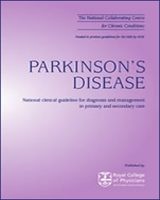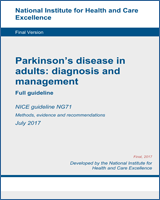All rights reserved. No part of this publication may be reproduced in any form (including photocopying or storing it in any medium by electronic means and whether or not transiently or incidentally to some other use of this publication) without the written permission of the copyright owner. Applications for the copyright owner’s written permission to reproduce any part of this publication should be addressed to the publisher.
NCBI Bookshelf. A service of the National Library of Medicine, National Institutes of Health.
National Collaborating Centre for Chronic Conditions (UK). Parkinson's Disease: National Clinical Guideline for Diagnosis and Management in Primary and Secondary Care. London: Royal College of Physicians (UK); 2006. (NICE Clinical Guidelines, No. 35.)
This publication is provided for historical reference only and the information may be out of date.

Parkinson's Disease: National Clinical Guideline for Diagnosis and Management in Primary and Secondary Care.
Show details1.1. Background
Parkinson’s disease (PD) is named after the London general practitioner (GP), James Parkinson, who vividly described many of the clinical features of the condition in his Essay on the shaking palsy (1817).5
In this work, Parkinson refers to the condition by its earlier name of paralysis agitans, a term that captures a peculiar characteristic of the disease, namely the combination of movement loss (ie hypokinesia) with movement gain (ie tremor at rest) which characterises the condition.6
Shaking palsy was named ‘maladie de Parkinson’ in 1888 by the French neurologist Jean-Martin Charcot. Charcot admired Parkinson’s clinical acumen and powers of description, but criticised him for omitting mention of rigidity, which Charcot believed to be a typical feature of the condition.7
1.2. Modern definition
PD is a progressive neurodegenerative condition resulting from the death of the dopamine containing cells of the substantia nigra. There is no consistently reliable test that can distinguish PD from other conditions that have similar clinical presentations. The diagnosis is primarily a clinical one based on the history and examination.
People with PD classically present with the symptoms and signs associated with parkinsonism, namely hypokinesia (ie poverty of movement), bradykinesia (ie slowness of movement), rigidity and rest tremor.
Parkinsonism can also be caused by drugs and less common conditions such as: multiple cerebral infarction, and degenerative conditions such as progressive supranuclear palsy (PSP) and multiple system atrophy (MSA).
Although PD is predominantly a movement disorder, other impairments frequently develop, including psychiatric problems such as depression and dementia. Autonomic disturbances and pain may later ensue, and the condition progresses to cause significant disability and handicap with impaired quality of life for the affected person. Family and carers may also be affected indirectly.
1.3. Health and resource implications
PD is a common, progressive neurological condition, estimated to affect 100–180 per 100,000 of the population (6–11 people per 6,000 of the general population in the UK)* and has an annual incidence of 4–20 per 100,000.8 There is a rising prevalence with age and a higher prevalence and incidence of PD in males.9
PD can lead to extensive disability, which affects both the individual with the disease as well as indirectly family and carers. The economic impact of the disease includes:
- direct cost to the National Health Service (NHS)
- indirect cost to society
- personal impact of PD on individuals with the condition and their family and carers.
The direct costs of treatment to the NHS have been estimated at approximately £2,298 (£ 1998) per patient per year.10 Significant cost drivers include the onset of motor fluctuations and dyskinesias.11 The condition is a frequent cause of falls and thus fractures and even death.12
The total annual cost of care including NHS, social services and private expenditure per patient in the UK has been estimated at approximately £5,993 (£ 1998).10 This results in direct costs of approximately £599,300,000 per year in the UK for 100,000 individuals with PD.10
Total costs of care increase with age and disease severity.10 Costs to the NHS were approximately 38% of the total costs.10
1.4. How to use this guideline
The purpose of this guideline is to support clinical judgement, not to replace it. This means the treating clinician should:
- take into consideration any contraindications in deciding whether or not to administer any treatment recommended by this guideline
- consider the appropriateness of any recommended treatment for a particular patient in terms of the patient’s relevant clinical and non-clinical characteristics.
Wherever possible, before administering any treatment the treating clinician should follow good practice in terms of:
- discussing with the patient why the treatment is being offered and what health outcomes are anticipated
- highlighting any possible adverse events or side-effects that have been associated with the treatment
- obtaining explicit consent to administer the treatment.
For those recommendations involving pharmacological treatment, the most recent edition of the British National Formulary (BNF) should be followed for the determination of:
- indications
- drug dosage
- method and route of administration
- contraindications
- supervision and monitoring
- product characteristics
except in those cases where guidance is provided within the recommendation itself.
Footnotes
- *
The size of the average general practice list in the UK.
- Introduction - Parkinson's DiseaseIntroduction - Parkinson's Disease
- TPA: Drosophila grimshawi raptor (DgriCAF1_raptor-PC) mRNA, complete cdsTPA: Drosophila grimshawi raptor (DgriCAF1_raptor-PC) mRNA, complete cdsgi|2787449532|tpg|BK065261.1|Nucleotide
- Homo sapiens mRNA for NAD(P)H dehydrogenase, quinone 2 variant proteinHomo sapiens mRNA for NAD(P)H dehydrogenase, quinone 2 variant proteingi|62089143|dbj|AB209779.1|Nucleotide
- Homo sapiens xin actin binding repeat containing 1 (XIRP1), transcript variant 1...Homo sapiens xin actin binding repeat containing 1 (XIRP1), transcript variant 1, mRNAgi|1519243787|ref|NM_194293.4|Nucleotide
- tectonin beta-propeller repeat-containing protein 1 isoform 1 [Mus musculus]tectonin beta-propeller repeat-containing protein 1 isoform 1 [Mus musculus]gi|124249058|ref|NP_081686.1|Protein
Your browsing activity is empty.
Activity recording is turned off.
See more...
